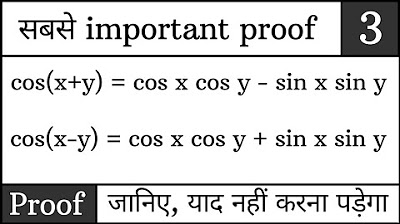APPLYING DISTANCE FORMULA TO PROVE GEOMETRIC PROPERTIES
Summary
TLDRIn this tutorial, the presenter discusses how to apply the distance formula to prove geometric properties, specifically focusing on triangles and quadrilaterals. The video explores how to determine whether a triangle is isosceles and how to demonstrate that a quadrilateral is a square by examining their properties. Through step-by-step examples, the presenter shows how to calculate distances between points on the Cartesian plane, proving the congruency of sides in an isosceles triangle and the equality of sides and right angles in a square. The tutorial concludes with the calculation of the perimeter of a square, reinforcing key concepts in geometry.
Takeaways
- 😀 The distance formula is a useful tool for proving geometric properties of shapes, such as triangles and quadrilaterals.
- 😀 An isosceles triangle has two equal sides. This can be proven by calculating the lengths of its sides using the distance formula.
- 😀 The distance formula is: D = √[(x2 - x1)² + (y2 - y1)²], and it is used to find the distance between two points on a Cartesian plane.
- 😀 An equilateral triangle has all sides equal, while a scalene triangle has no equal sides.
- 😀 A quadrilateral is a four-sided polygon, and it can be classified into different types, such as squares, rectangles, and rhombuses.
- 😀 To prove a quadrilateral is a square, you must demonstrate that all sides are equal and that all angles are right angles.
- 😀 The distance between points A(-3,1) and B(1,4) is 5 units, and this is calculated using the distance formula.
- 😀 When proving a triangle is isosceles, you must find the lengths of all sides and check if two sides are equal in length.
- 😀 A square's diagonals are also equal in length and intersect at right angles, a key property when proving that a quadrilateral is a square.
- 😀 The perimeter of a square can be calculated as 4 times the length of one side. If the side length is √74, the perimeter is 4√74 units.
Q & A
What is the purpose of using the distance formula in geometry?
-The distance formula is used to calculate the distance between two points in a coordinate plane. In the video, it is applied to prove various geometric properties, such as whether a triangle is isosceles or a quadrilateral is a square.
How do you classify triangles based on their sides?
-Triangles can be classified into three types based on their sides: equilateral (all sides equal), isosceles (two sides equal), and scalene (no sides equal).
What is an isosceles triangle, and how can it be identified using the distance formula?
-An isosceles triangle has two equal sides. To identify if a triangle is isosceles using the distance formula, you calculate the lengths of the sides and check if two of the sides are equal.
How do you apply the distance formula to find the length of a side of a triangle?
-To apply the distance formula, you substitute the coordinates of the two points that define the side into the formula: D = √[(x2 - x1)² + (y2 - y1)²], where (x1, y1) and (x2, y2) are the coordinates of the points.
What are the properties of a square?
-A square has four equal sides, all angles are right angles (90 degrees), and the two diagonals are also equal in length.
What properties must be verified to prove a quadrilateral is a square?
-To prove a quadrilateral is a square, you must show that all four sides are equal in length and that all four angles are right angles.
How do you find the perimeter of a square?
-The perimeter of a square is found by multiplying the length of one side by 4, as all sides are equal. If the side length is √74, the perimeter would be 4√74 units.
What is the significance of negative reciprocal slopes in proving right angles?
-If two lines are perpendicular, their slopes are negative reciprocals of each other. In the context of the square, checking if the slopes of adjacent sides are negative reciprocals helps prove that the angles between them are 90 degrees.
Why is the distance formula important for proving that triangle ABC is isosceles?
-The distance formula is used to calculate the lengths of the sides of triangle ABC. If two sides are equal in length, the triangle is proven to be isosceles.
How did the video demonstrate that the quadrilateral formed by points L, O, V, and E is a square?
-The video demonstrated that the quadrilateral formed by these points is a square by showing that all four sides are equal in length (using the distance formula) and by proving that all angles are right angles (using the concept of negative reciprocal slopes).
Outlines

هذا القسم متوفر فقط للمشتركين. يرجى الترقية للوصول إلى هذه الميزة.
قم بالترقية الآنMindmap

هذا القسم متوفر فقط للمشتركين. يرجى الترقية للوصول إلى هذه الميزة.
قم بالترقية الآنKeywords

هذا القسم متوفر فقط للمشتركين. يرجى الترقية للوصول إلى هذه الميزة.
قم بالترقية الآنHighlights

هذا القسم متوفر فقط للمشتركين. يرجى الترقية للوصول إلى هذه الميزة.
قم بالترقية الآنTranscripts

هذا القسم متوفر فقط للمشتركين. يرجى الترقية للوصول إلى هذه الميزة.
قم بالترقية الآنتصفح المزيد من مقاطع الفيديو ذات الصلة

cos(x+y)=cosx cosy-sinx siny | cos(x+y)=cosx cosy-sinx siny derivation | Trigonometry formula proof

Kontruksi Geometri_(Masalah 3.1, Masalah 3.2, & Masalah 3.3)_Selvia Widi Astuti_A1C020004

Kesebangunan Segitiga: Kesebangunan Segitiga Siku-siku (Belajar Matematika Kelas 7) - Kak Hasan

Sifat-Sifat Dua Segitiga Sebangun

Transformasi Refleksi, Pencerminan Titik Terhadap Sumbu X - Matematika Tingkat Lanjut Kelas XI

Kekongruenan dan Kesebangunan [Part 2] - Kekongruenan Dua Segitiga
5.0 / 5 (0 votes)
